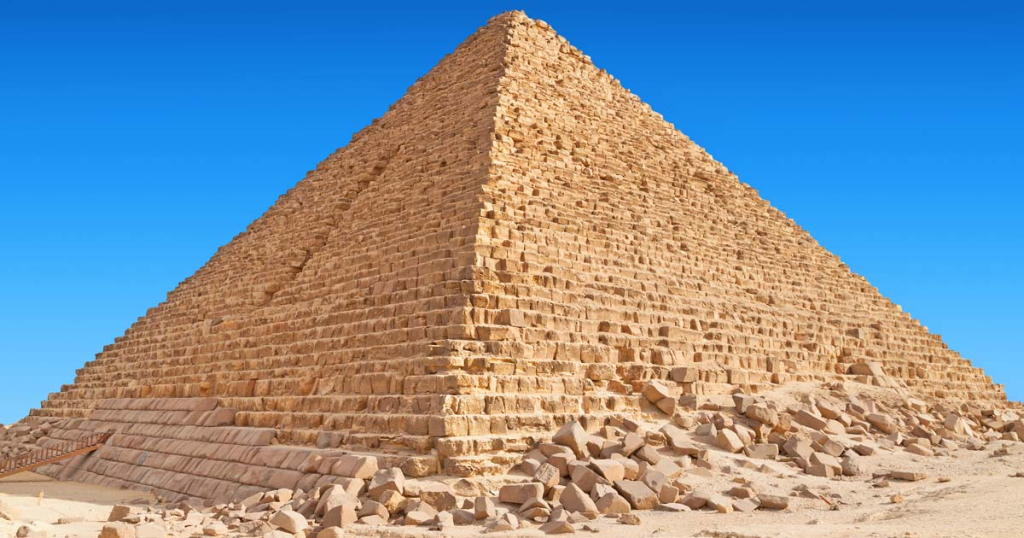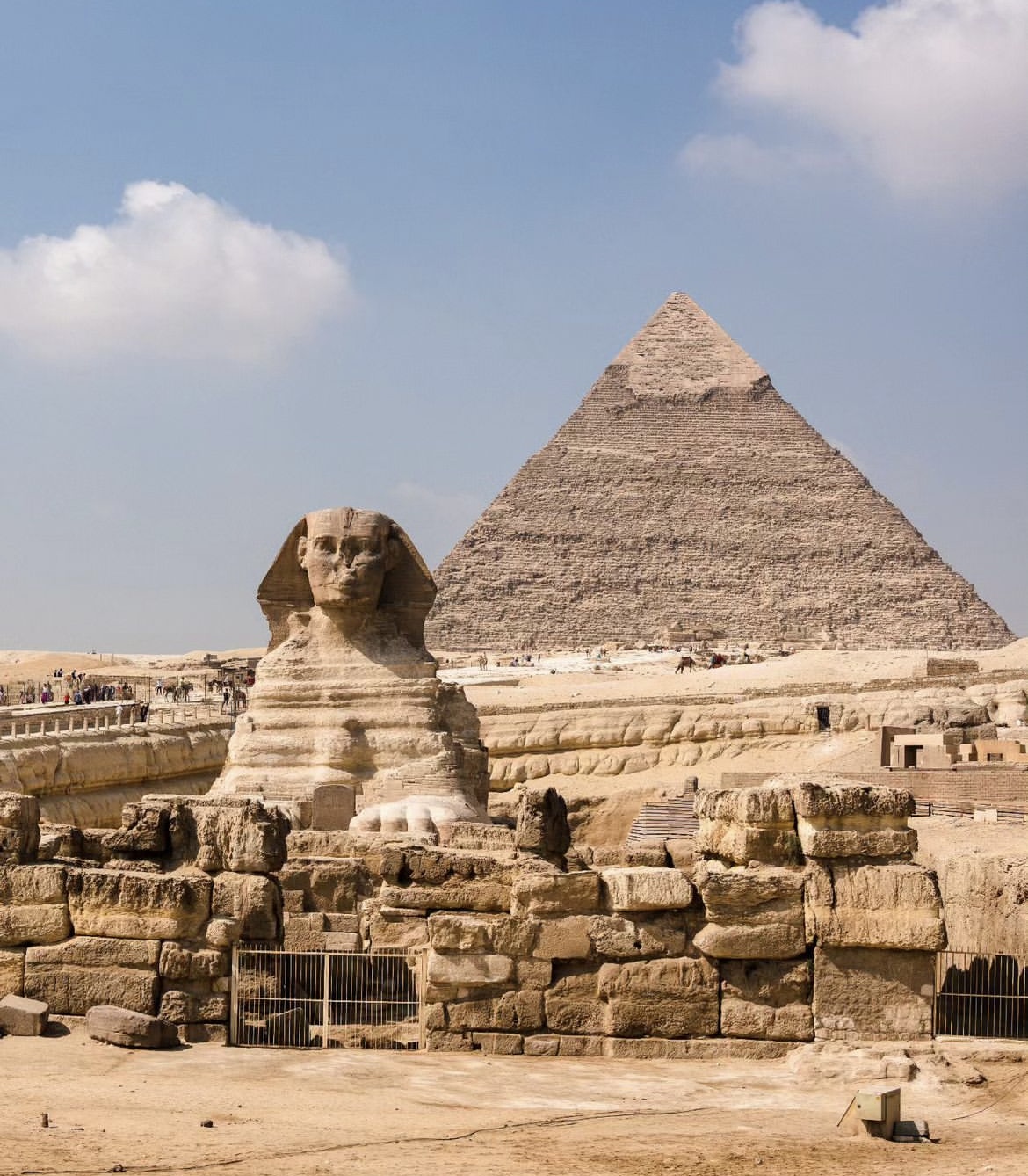
The Great Pyramid of Giza stands as an awe-inspiring testament to human ingenuity, engineering prowess, and cultural significance. Situated on the Giza Plateau, just outside Cairo, Egypt, this iconic monument has captured the imagination of people worldwide for centuries. Shrouded in mystery and rich in history, the Great Pyramid continues to be a subject of fascination, offering insights into the ancient world’s architectural marvels and cultural significance.
1. The Monumental Feat of Construction
Built during the reign of Pharaoh Khufu in the 26th century BCE, the Great Pyramid is the largest and oldest of the three pyramids in Giza. Its construction remains an astonishing feat of engineering, considering the tools and technology available at the time. The pyramid’s massive limestone blocks, some weighing several tons, were quarried from nearby sites and meticulously placed to form the structure’s perfectly aligned edges and corners.
The construction process is still a topic of debate among historians and archaeologists, with theories ranging from elaborate ramps to intricate pulley systems. Regardless of the method, the sheer precision of the construction reflects the ancient Egyptians’ mastery of mathematics, engineering, and architecture.
2. Cosmic Alignment and Astronomical Significance
One of the most intriguing aspects of the Great Pyramid is its alignment with remarkable accuracy to true north. The pyramid’s sides are oriented to the cardinal points of the compass with minimal deviation, an achievement that hints at the ancient Egyptians’ understanding of celestial mechanics. Some theorists propose that this alignment served an astronomical purpose, possibly tied to the observation of solstices and equinoxes.
Additionally, the pyramid’s dimensions are believed to encode mathematical constants like Pi (π) and the golden ratio (φ), suggesting a profound connection between its architecture and the natural world.
3. Cultural and Spiritual Significance
The Great Pyramid’s significance extends beyond its engineering marvels. In ancient Egyptian society, pyramids served as monumental tombs for pharaohs and high-ranking officials, reflecting their beliefs in the afterlife and the ruler’s divine connection. The pyramid complex included not only the pyramid itself but also temples, causeways, and smaller pyramids for the pharaoh’s consorts and family members.
The intricate hieroglyphs and inscriptions found within the pyramid walls provide insight into the religious rituals, myths, and daily life of the ancient Egyptians. These inscriptions underline the pyramid’s role as a bridge between the earthly realm and the realm of the gods.
4. Modern Discoveries and Ongoing Research
Despite centuries of exploration and study, the Great Pyramid continues to reveal new insights. Modern technologies like ground-penetrating radar and laser scanning have enabled researchers to map the pyramid’s internal structures and hidden chambers without causing damage to the ancient monument.
Recent discoveries include the identification of voids within the pyramid, sparking speculation about their purpose and function. Ongoing research also aims to unravel the mysteries surrounding the construction techniques and labor force involved in building the pyramid.
The Great Pyramid of Giza FAQs
1. What is the Great Pyramid of Giza? The Great Pyramid of Giza is a massive ancient monument located on the Giza Plateau, just outside Cairo, Egypt. It is the oldest and largest of the three pyramids in the Giza pyramid complex.
2. Who built the Great Pyramid of Giza? The exact identity of the builders remains a subject of debate among historians and archaeologists. The prevailing theory is that the pyramid was built during the reign of Pharaoh Khufu (also known as Cheops) of the Fourth Dynasty of the Old Kingdom of Egypt, around 2550 BC.
3. How was the Great Pyramid built? The construction of the pyramid is still somewhat shrouded in mystery. It’s believed that the massive limestone blocks were quarried nearby and transported to the site using sleds, rollers, and possibly waterways. The blocks were then lifted into place using ramps, either straight or zigzagging up the sides of the pyramid.
4. What are the dimensions of the Great Pyramid? The original height of the Great Pyramid was approximately 146.6 meters (481 feet), but due to erosion and the loss of the outer casing stones, it currently stands at around 138.8 meters (455 feet). Its base has sides measuring about 230.4 meters (756 feet), making it one of the largest structures of its time.
5. What was the purpose of the Great Pyramid? The exact purpose of the Great Pyramid is still debated, but it’s commonly believed to have been a tomb for Pharaoh Khufu. Its internal structure includes various chambers, such as the King’s Chamber and the Queen’s Chamber, which were likely intended for burial and ritualistic purposes.
6. How were the pyramids aligned? The Great Pyramid, along with the other pyramids in the complex, was precisely aligned with the cardinal points (north, south, east, west). The accuracy of the alignment is remarkable considering the era’s technology.
7. How many pyramids are at the Giza complex? There are three main pyramids at the Giza complex: the Great Pyramid of Khufu, the Pyramid of Khafre (Chephren), and the Pyramid of Menkaure. These pyramids were built for the pharaohs and their royal relatives.
8. What are the Sphinx and its relationship with the pyramids? The Great Sphinx of Giza is a colossal statue with the body of a lion and the head of a pharaoh, believed by many to represent Pharaoh Khafre. It is located near the Pyramid of Khafre and is thought to have a connection to the pyramids, perhaps serving a protective or symbolic role.
9. Can you go inside the Great Pyramid? Yes, tourists are allowed to enter the Great Pyramid, but access to certain areas might be restricted or limited due to preservation efforts or safety concerns. The main chambers, such as the King’s Chamber, are typically open to visitors.
10. Why is the Great Pyramid significant? The Great Pyramid of Giza is not only a remarkable engineering and architectural achievement of the ancient world, but it also holds cultural, historical, and symbolic significance as a representation of the power and capabilities of the ancient Egyptian civilization.

